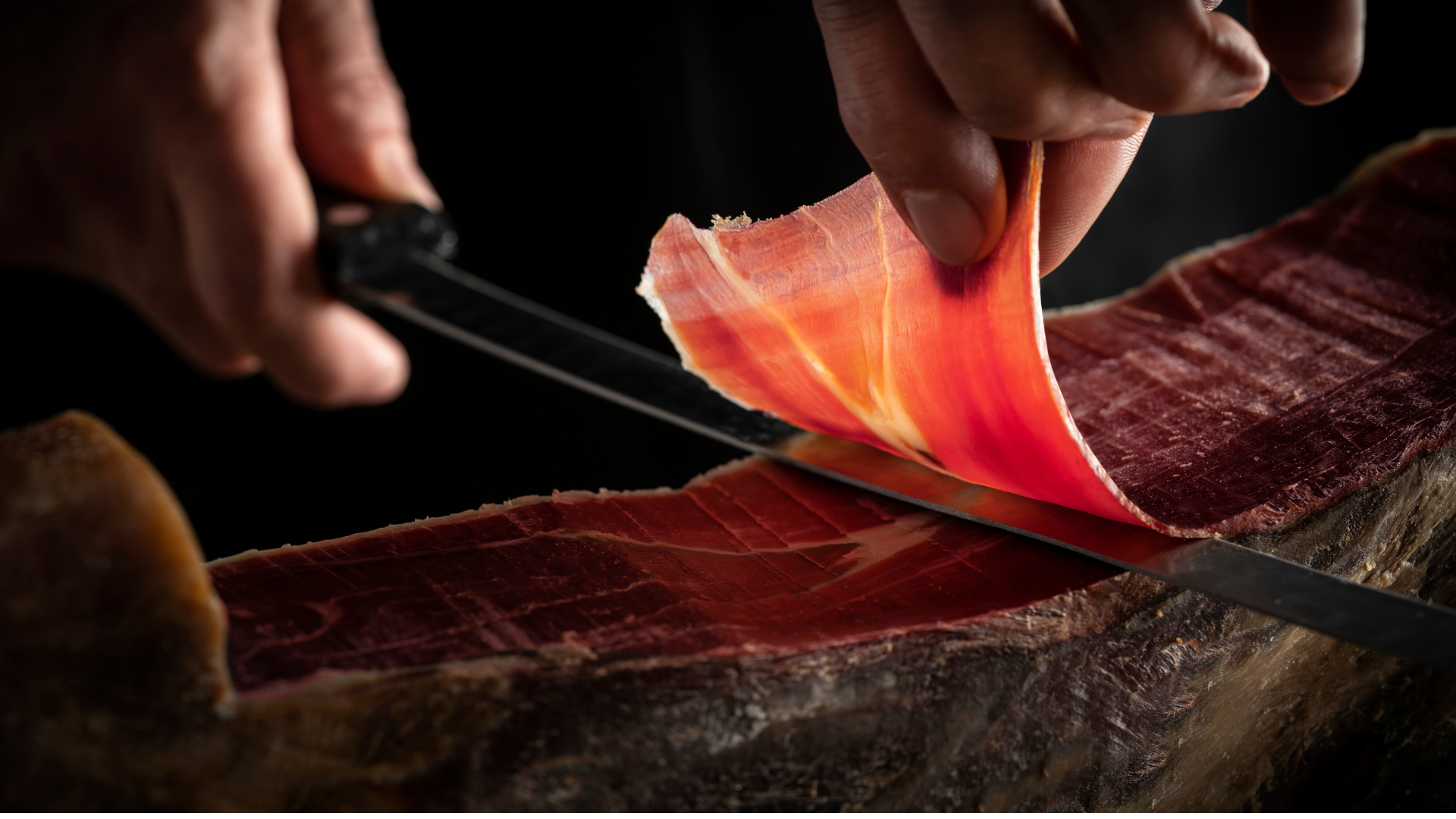
Cooking Ham/Tongue the French Way (Recipes)
French ham culture is deeply rooted in the country’s rich culinary history, with a wide range of regional varieties and preparation techniques that reflect France’s devotion to gastronomy. Here’s a look at the traditions, types, and cultural significance of ham in France:
Types of French Ham
French ham is typically divided into two categories: raw ham (jambon cru) and cooked ham (jambon cuit). Each type has its own unique production methods and flavor profiles.
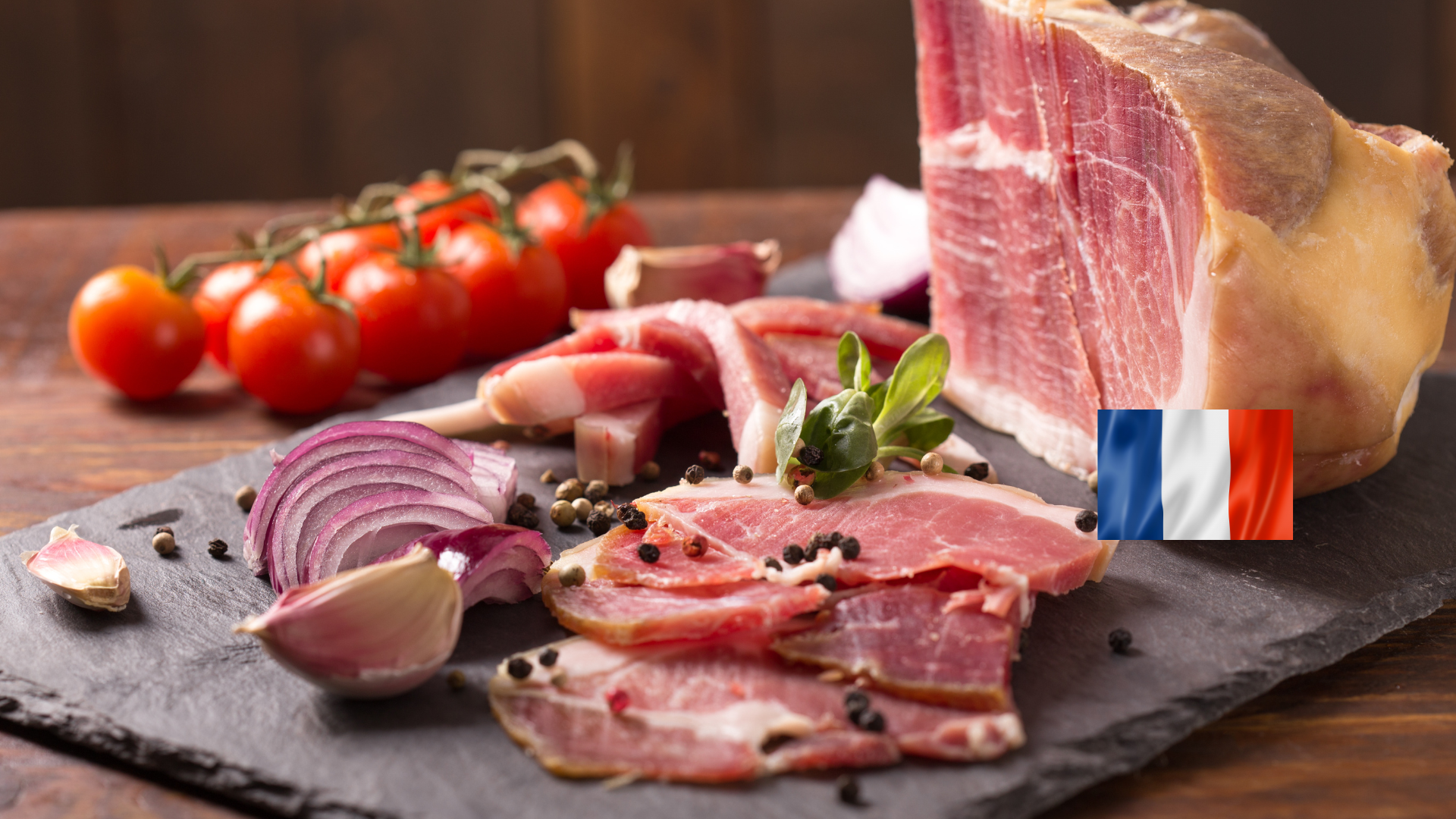
Jambon Cru (Raw Ham): Jambon cru is dry-cured and air-dried, similar to Spanish jamón or Italian prosciutto. It is prized for its deep, intense flavor and is often enjoyed thinly sliced, either on its own or as part of charcuterie platters.
Famous varieties of jambon cru include:
Jambon de Bayonne: One of the most famous French hams, produced in the southwest of France near Bayonne. It has Protected Geographical Indication (PGI) status, which ensures its quality and origin. Bayonne ham is sweet, delicate, and air-cured using traditional methods with local salt.
Jambon de Savoie: From the alpine region of Savoy, this ham is cured in cool mountain air, giving it a subtle, earthy flavor. It is usually served thinly sliced in regional dishes or alongside cheeses like Raclette.
Jambon d’Auvergne: From the mountainous Auvergne region, this ham has a robust, slightly smoky flavor. It is known for being a bit firmer than other raw hams.
Noir de Bigorre: A prestigious ham made from the meat of the black Gascon pig, native to the Pyrenees. It’s prized for its marbled fat and nutty, rich taste.
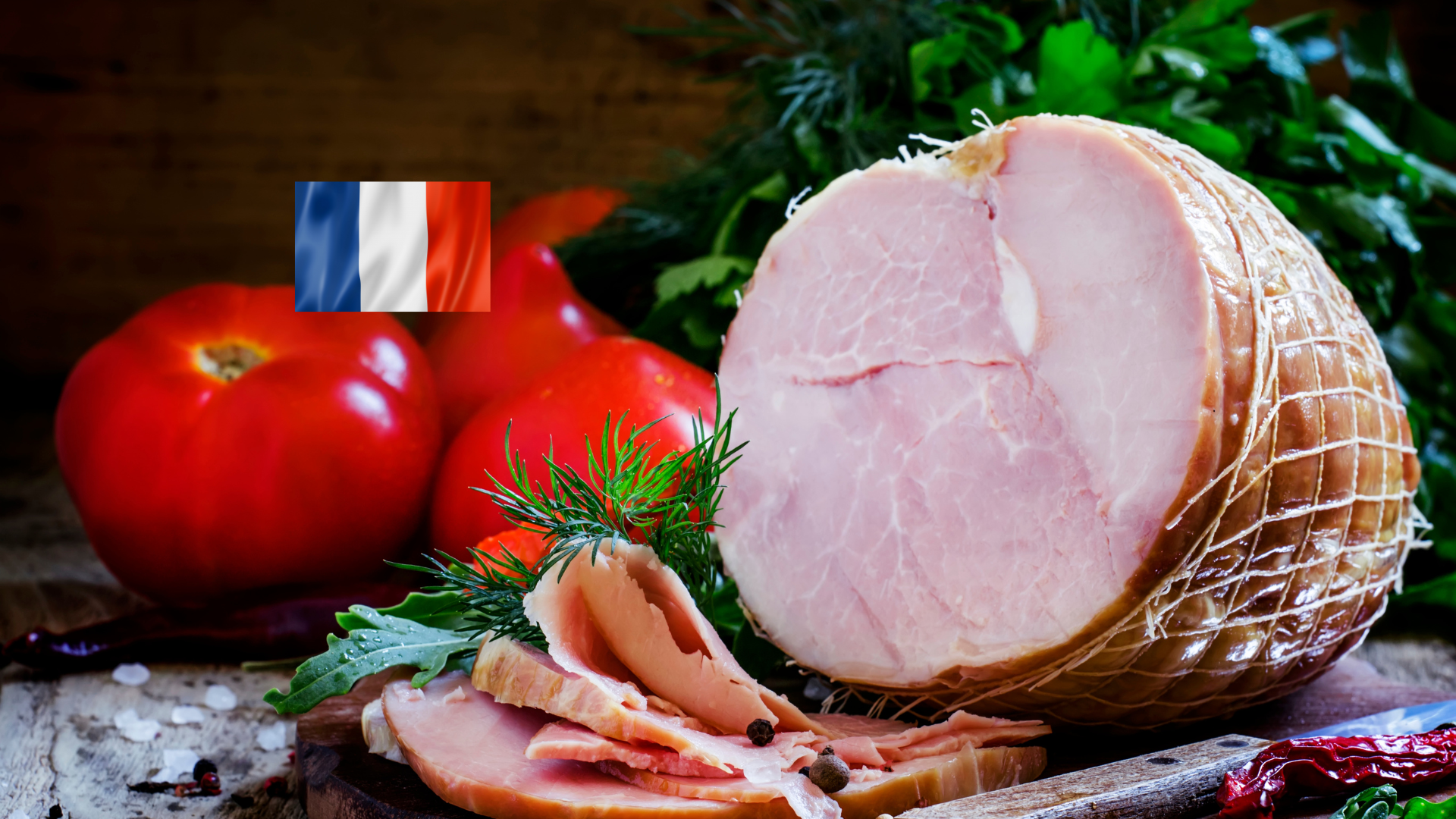
Jambon Cuit (Cooked Ham): Jambon cuit is typically wet-cured and then cooked or steamed, resulting in a tender, mild-flavored ham that is commonly used in everyday French cuisine.
Jambon Blanc (White Ham): This is the most common type of cooked ham, simply boiled or steamed, and eaten cold in sandwiches (like the famous "jambon-beurre") or on platters.
Jambon à l’Os (Ham on the Bone): A more flavorful and traditional variation, often baked or braised, giving it a richer taste. It is usually served warm in slices, especially during holidays.
Regional specialties of cooked ham include:
Jambon de Paris: A classic city ham, delicate and mildly seasoned, often seen in the famous "Croque Monsieur" sandwich. It’s usually made with brine-cured pork, cooked and sold unsmoked.
Jambon Persillé (Parsleyed Ham): This is a specialty of the Burgundy region, where the ham is mixed with parsley and garlic, set in a jelly made from stock. It’s served as a cold dish, often as part of festive meals.
Cultural Traditions
Ham plays a central role in French charcuterie culture, which is the art of preparing preserved meats. This tradition dates back to the Middle Ages, when families and butchers would cure meats for preservation. Today, ham is a staple of aperitif culture, where it is served as part of charcuterie boards alongside pâtés, rillettes, sausages, cheeses, and breads.
Seasonal and Festive Occasions: Ham is often featured during festive gatherings and regional festivals. For example, in the town of Bayonne, the annual Foire au Jambon (Ham Fair) celebrates the region’s iconic ham with tastings, demonstrations, and competitions. Similarly, Jambon de Paris is often served in elegant, celebratory meals in the capital city.
In some parts of France, cooked ham or ham-based dishes are enjoyed during Easter and other holidays, symbolizing a feast after the fasting period of Lent.
Roasted Ham
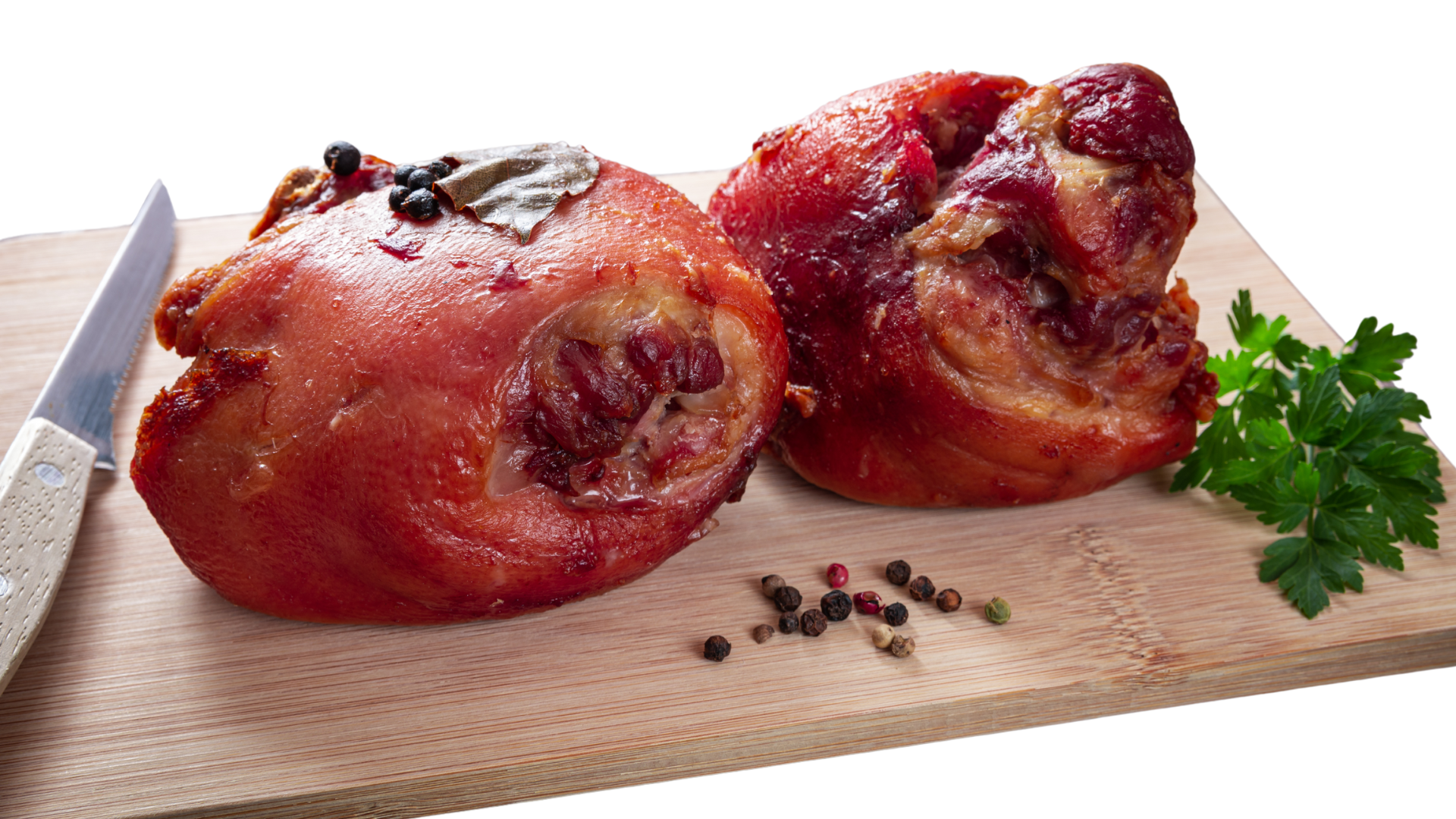
Soak the Ham
Classic
Soak the ham overnight in cold water. The next day, trim it neatly and carefully remove the bone by loosening the meat around it with the tip of a knife. Tie a broad tape around the ham to help maintain its shape.
Place the ham in a large pan with some sliced onions, a few sprigs of parsley, two or three bay leaves, and a bottle of white wine. Cover the pan and let the ham marinate in this mixture for 24 hours.
When ready to cook, roast the ham, basting it with the marinade. A large ham will need about four to five hours in the oven. Shortly before it’s fully cooked, remove the skin and sprinkle the ham with grated breadcrumbs for a finishing touch.
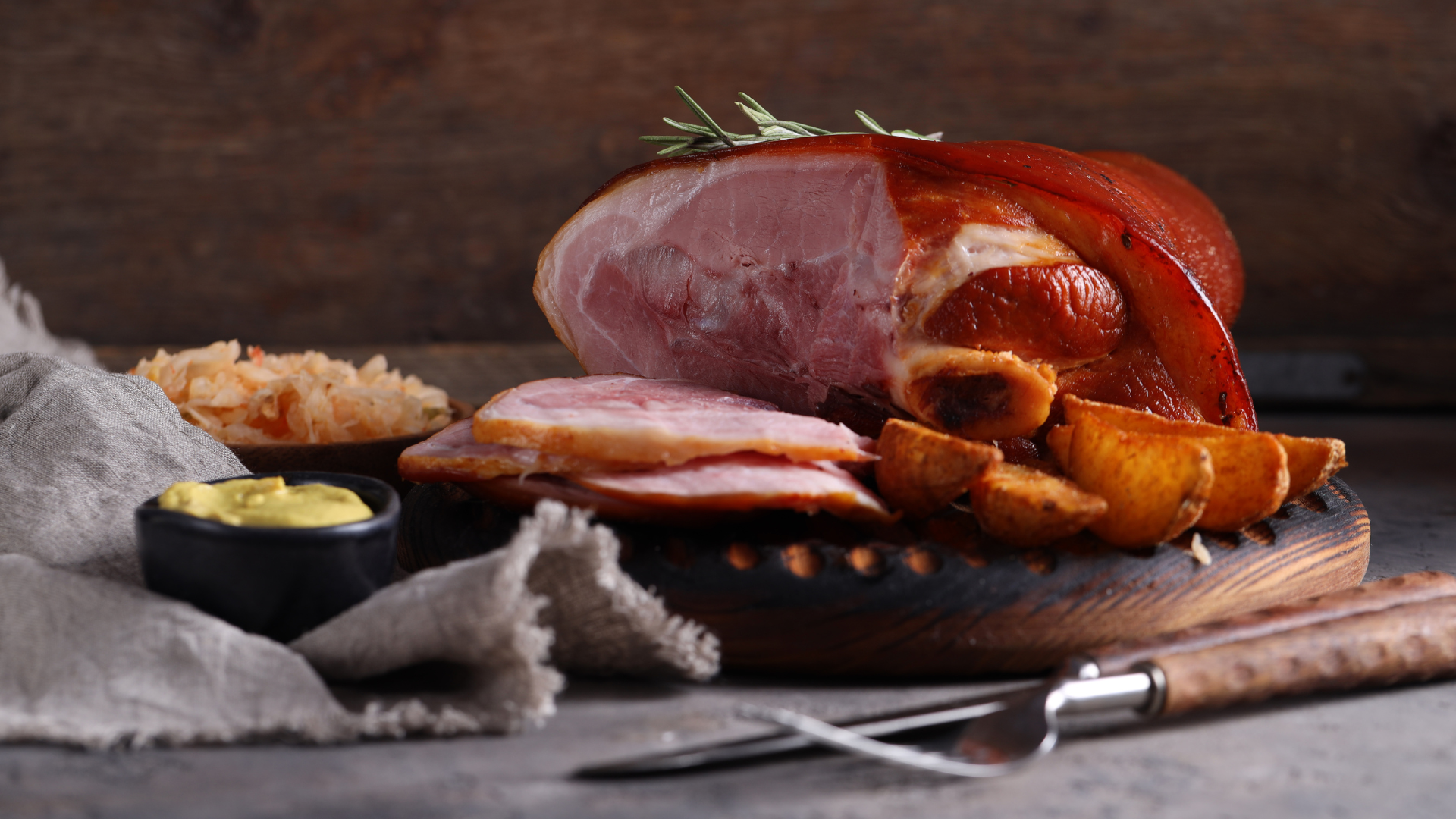
Jellying the Ham
Classic
While the ham is roasting, stew the bone, trimmings, and scraps until they reduce to a jelly. Strain the jelly through a sieve. Once you remove the ham from the spit (after untying the tape), glaze the ham with the jelly, applying it evenly with a brush or feather. Serve the ham with the marinade or seasoning poured underneath.
If the ham is to be served cold, you can cover it with finely grated cold boiled potatoes, giving it the appearance of a large cake covered in icing. Decorate the surface with slices of boiled carrots, beets, or other vegetables, arranging them in scalloped or artistic patterns to create a look of red and yellow flowers.
For an extra touch, place a large bunch of curly parsley in the center. A ham boiled in the traditional way can be decorated similarly—first removing the bone and shaping the meat into a circular form.
Fried Ham with Tomatoes
Fry slices of cold-boiled ham until they are golden and crisp. In the same pan, fry tomatoes, using one tomato for each slice of ham. Place the cooked tomatoes on top of the ham, sprinkle with pepper, and serve immediately.
Roasted Ham Recipe (Jambon Rôti)
French roasted ham, or jambon rôti, is a classic dish enjoyed across France, especially during festive occasions. The preparation involves slow-roasting a whole ham, often glazed with a flavorful mix of honey, mustard, or spices.
History of French Roasted Ham (Jambon Rôti)
Roasted ham, while simple, has deep roots in French culinary traditions and European gastronomy. In France, jambon (ham) has been a prominent part of the food culture since antiquity, with evidence of cured ham dating back to the Gauls, a Celtic people who inhabited the region before Roman influence. The Gauls were known for raising pigs, curing pork, and creating some of the earliest versions of ham.
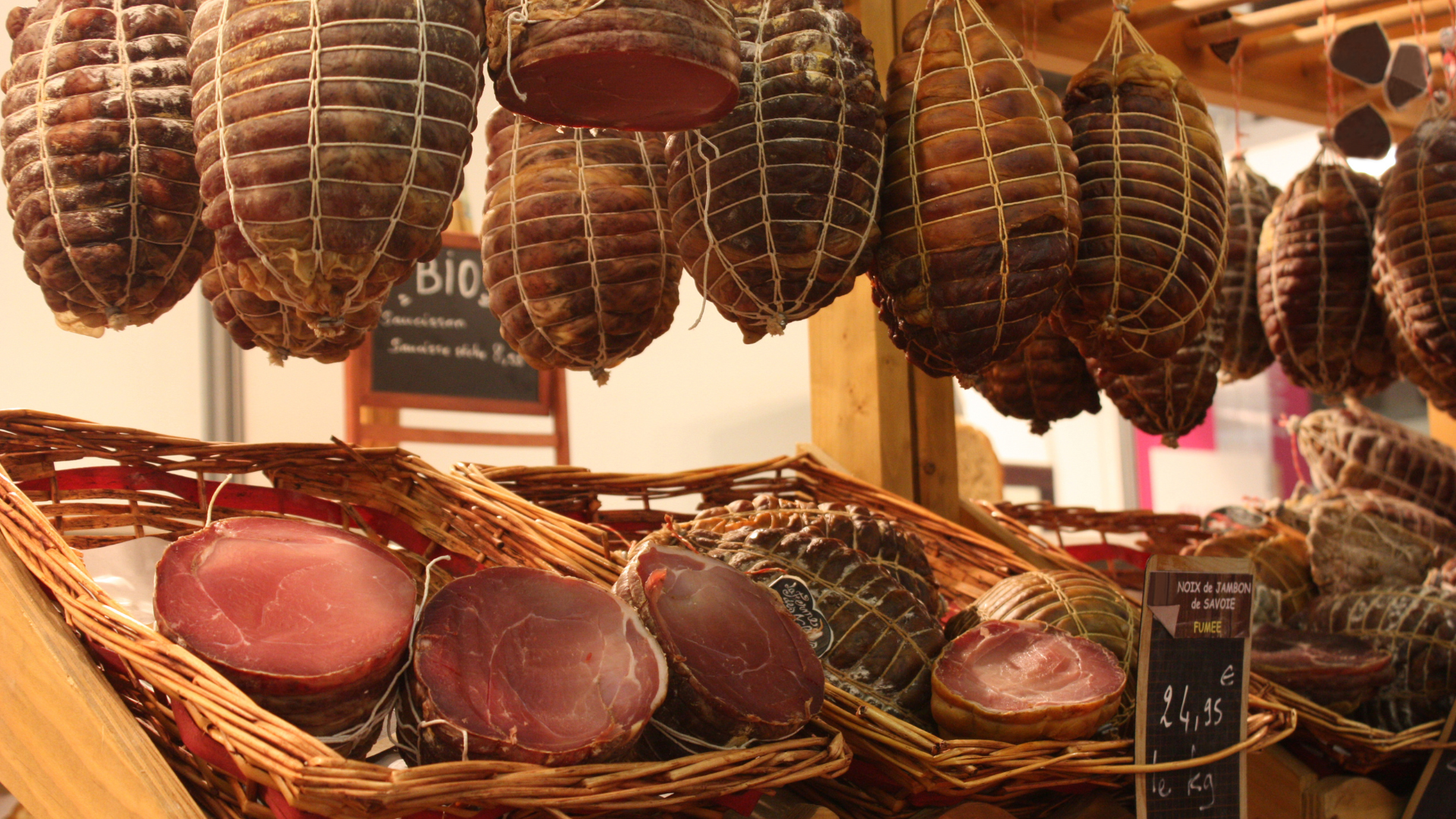
During Roman times, the techniques of smoking and salting ham spread across Europe, and ham became a staple for special occasions. Over centuries, the preparation of ham evolved, and different regions of France developed their own distinct styles. For instance:
Jambon de Paris: A mild, unsmoked ham often used for sandwiches or served cold.
Jambon de Bayonne: A renowned cured ham from the southwest of France, much like Spanish jamón serrano.
Roasting ham in the oven, as in jambon rôti, became particularly popular in more recent centuries. This method was favored in the 19th century with the advent of modern ovens, allowing for even roasting and caramelizing glazes. The dish became associated with family gatherings, holidays (especially Easter and Christmas), and festive meals, representing abundance and celebration.
Ham in French Gastronomy:
Ham is celebrated not only in roasted form but also cured, smoked, and cooked in various regional specialties. For instance:
Jambon persillé: A terrine made of ham and parsley, originating from Burgundy.
Quiche Lorraine: A savory pie with ham and cheese.
Croque-monsieur: The famous ham and cheese sandwich.
In modern French cuisine, jambon rôti is seen as a return to rustic, comforting dishes that celebrate the quality of simple ingredients. The traditional preparation emphasizes the natural flavor of the meat, enhanced by classic French ingredients like mustard, honey, and aromatic herbs.

-
French roasted ham, or jambon rôti, is a classic dish enjoyed across France, especially during festive occasions. The preparation involves slow-roasting a whole ham, often glazed with a flavorful mix of honey, mustard, or spices.
Ingredients:
1 whole bone-in ham (around 4–5 kg)
4 cloves garlic (slivered)
2 onions (sliced)
1 tbsp Dijon mustard
2 tbsp honey (or maple syrup)
1 tbsp apple cider vinegar (or white wine vinegar)
1 tsp ground black pepper
1 tsp cloves (whole or ground)
2 bay leaves
500 ml chicken or vegetable broth (or water)
1 tbsp olive oil
Salt to taste
Optional: 2-3 sprigs of thyme or rosemary for extra flavor
Instructions:
Preheat the oven: Heat your oven to 170°C (325°F).
Prepare the ham:
Use a sharp knife to score the surface of the ham in a diamond pattern (if it hasn't already been scored by the butcher).
Insert garlic slivers into the ham's surface.
Make the glaze:
Mix together the mustard, honey, vinegar, olive oil, and pepper. Brush this over the surface of the ham.
Prepare the roasting dish:
Place the onion slices at the bottom of a roasting pan, forming a bed for the ham.
Add the bay leaves, cloves, and thyme/rosemary (if using).
Place the ham on top of the onions and pour the broth (or water) into the pan to keep the ham moist while roasting.
Roast the ham:
Cover the ham loosely with foil to prevent it from drying out.
Roast the ham for about 2.5–3 hours (around 20 minutes per 500g), basting it every 30 minutes with the pan juices.
Final browning:
For the last 30 minutes, remove the foil to allow the ham to brown nicely.
You can brush on a little extra honey-mustard glaze for a shinier finish if desired.
Rest and serve:
Let the ham rest for 15–20 minutes before slicing. This helps the juices redistribute throughout the meat.
Serving suggestions:
Serve the roasted ham with sides such as roasted vegetables, mashed potatoes, or a fresh green salad. French dishes like gratin dauphinois (potato gratin) or a crusty baguette complement the meal wonderfully.
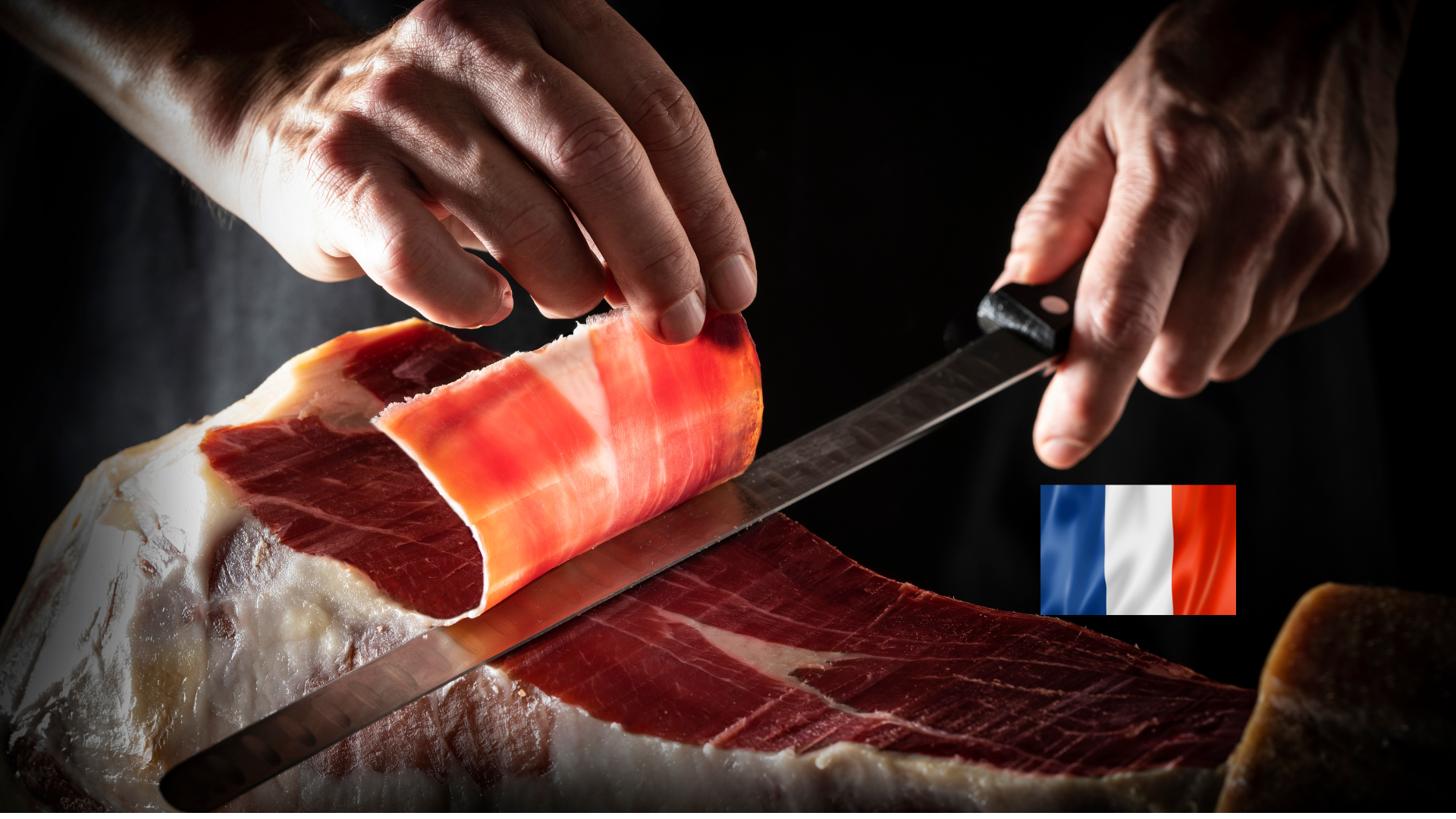
Ham in Modern French Life
Today, ham remains an important part of French daily life. You can find jambon in markets, delicatessens, and bakeries across the country. Whether served simply with bread and butter or as part of a more elaborate dish, ham represents a connection to French heritage and the country's enduring passion for high-quality food.
In conclusion, French ham traditions are diverse, reflecting the importance of regional identity, artisanal craftsmanship, and a deep appreciation for fine food. From the salty, cured varieties of jambon cru to the soft, tender slices of jambon blanc, ham is an indispensable part of French culture and cuisine.
Tongue
In French cuisine, cooking and consuming tongue (known as langue in French) is a long-standing tradition that exemplifies the culture's appreciation for using every part of an animal in cooking. Tongue, particularly from beef or veal, is considered a delicacy when prepared properly, offering a rich, tender texture and a subtle flavor that absorbs sauces and seasonings beautifully. Its preparation in France often involves slow-cooking or braising, combined with classic French sauces and accompaniments that elevate the dish into something refined.

Historical and Cultural Significance
The use of tongue in French cuisine reflects the traditional nose-to-tail philosophy that has been part of French cooking for centuries. This approach, which values the whole animal, not only honors the resourcefulness of French culinary heritage but also demonstrates the skill of French chefs in transforming less-common cuts into gourmet dishes. Tongue was historically considered more of a peasant food, as it was affordable and hearty. However, through the centuries, it has become a more revered ingredient in both home cooking and in traditional French bistro and brasserie dishes.
Types of Tongue Used in French Cuisine
Beef Tongue (Langue de Boeuf): The most commonly used tongue in French cuisine. It has a dense, rich texture and is typically slow-cooked to make it tender.
Veal Tongue (Langue de Veau): A more delicate and tender option than beef tongue, veal tongue is considered a bit finer and is often used in more elaborate or festive dishes.
Lamb or Pork Tongue: These are less common but are occasionally used in regional preparations, often in pâtés or terrines.
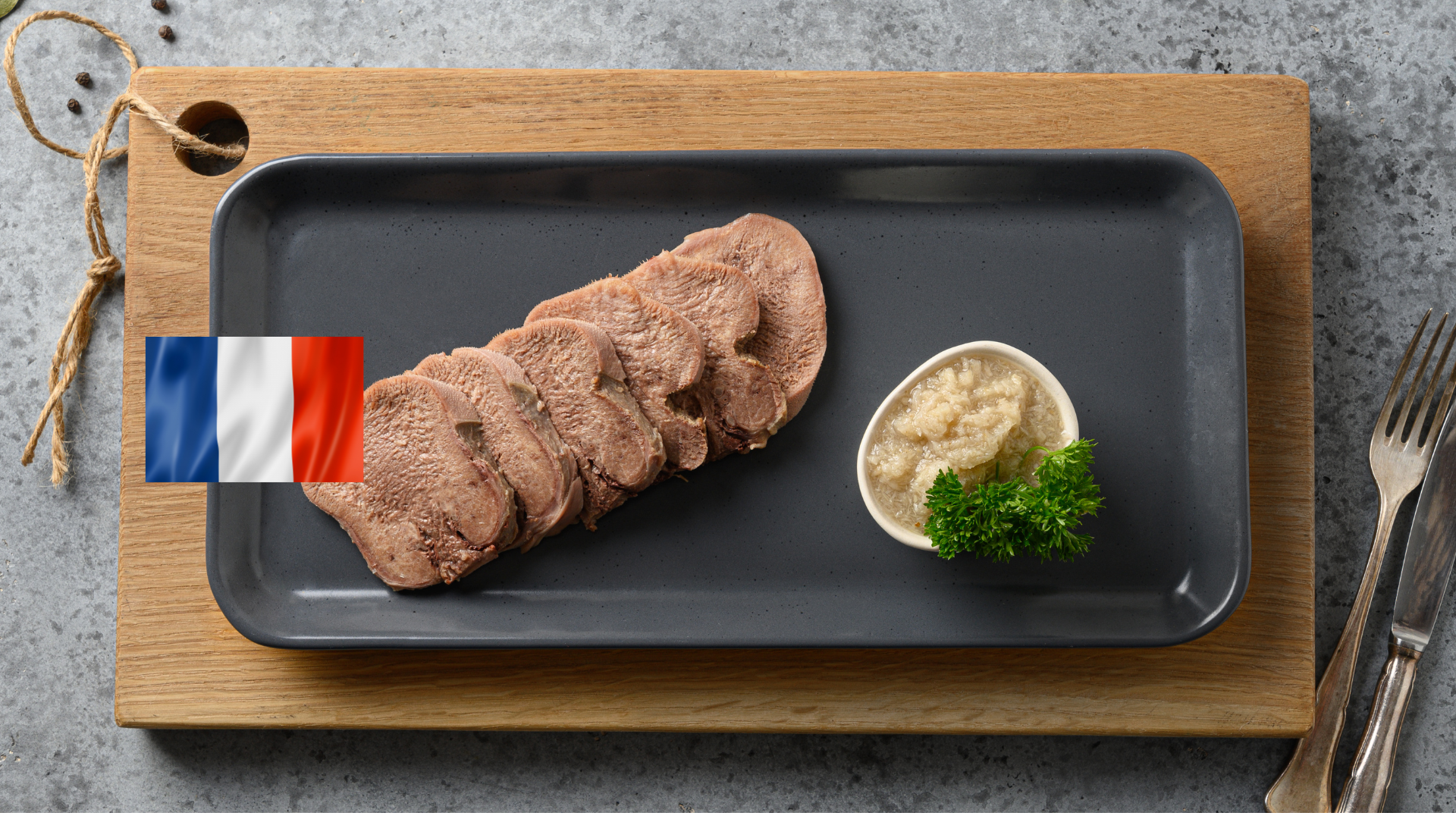
Techniques for Preparing Tongue in French Cuisine
Slow-Cooking: Beef or veal tongue is typically simmered for several hours to become tender. It is cooked in a flavorful broth made from vegetables, herbs, and spices. The key is to simmer it slowly so the collagen breaks down and the meat becomes soft without losing its structure.
Peeling: After the tongue is cooked, it must be peeled. The outer skin of the tongue, which is tough and leathery, is carefully removed after simmering, revealing the tender meat beneath.
Braising: Tongue is often braised in a flavorful liquid, such as wine or broth, which helps infuse the meat with deep flavors. Braising is particularly common in dishes like Langue de Boeuf Sauce Piquante, where the sauce is made in the same pan the tongue was cooked in.
Serving Cold: In traditional charcuterie, tongue is often served cold, either in slices or in terrines and aspics. This preparation allows the richness of the tongue to stand out, especially when paired with sharp flavors like mustard or pickles.
Roasted / Baked Tongue
Roasted Tongue
After soaking a large smoked tongue overnight in cold water, parboil it in a small amount of warm water along with a slice of bacon, a bundle of fresh herbs, and one or two onions studded with cloves. When it is almost cooked through, remove it, drain it, and lard the top with thick strips of bacon and the underside with smaller pieces. Place it on a spit and roast for half an hour. Serve with a tangy piquant sauce.
Baked Tongue
Slice a cold boiled tongue and set aside. In the bottom of a deep dish, mix a little vinegar with finely minced capers, parsley, and shallots, along with some breadcrumbs. Lay the tongue slices over this mixture, then cover them with another layer of the same seasoning. Sprinkle more breadcrumbs over the top. Moisten the dish by adding a bit of warm water. Place it in a moderately heated oven or on a slow-burning stove, and bake until golden brown.
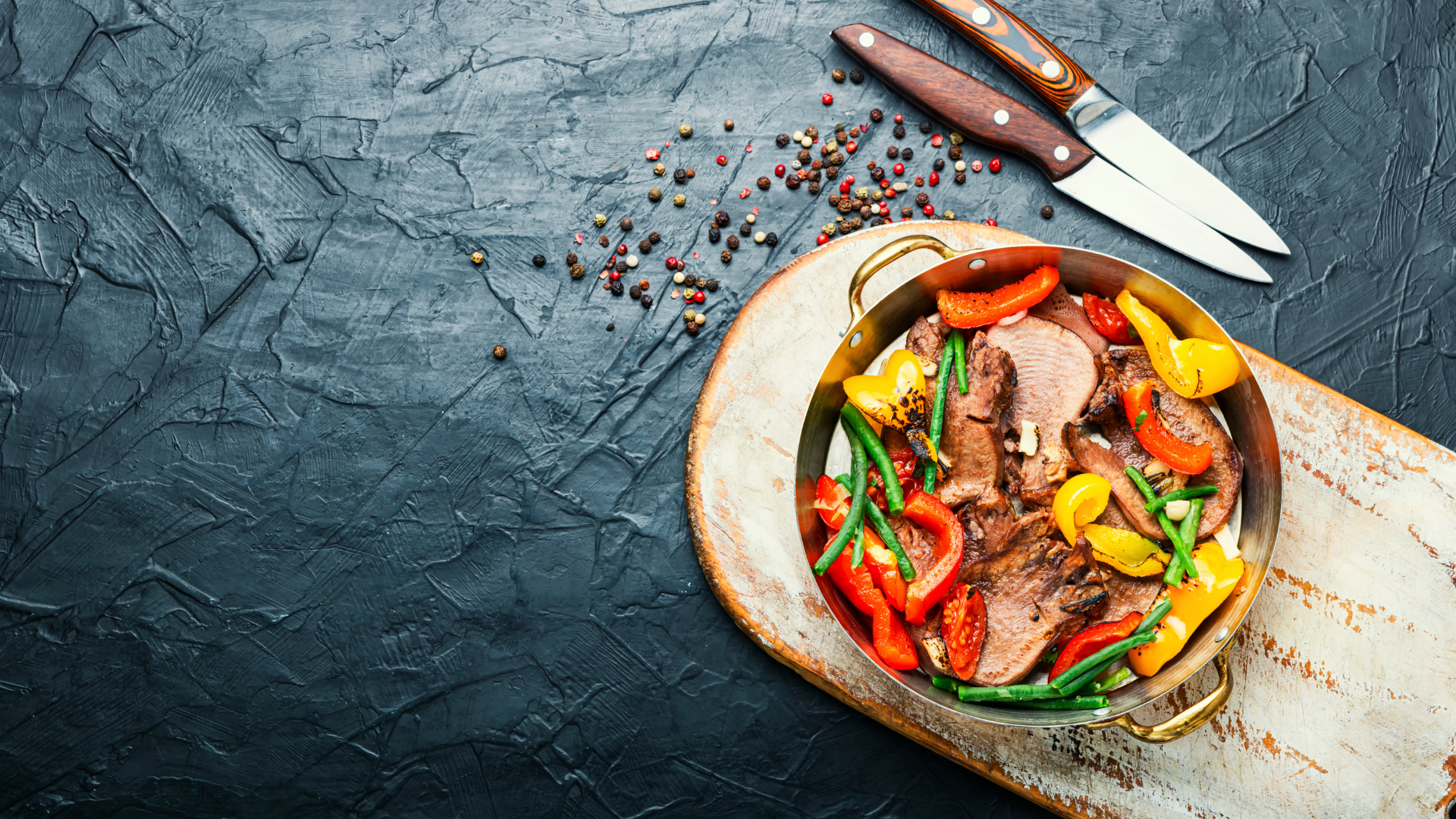
In French cuisine, the roasted or baked tongue is considered a delicacy. The dish is typically prepared with a beef or veal tongue and involves careful braising or roasting, often served with a rich sauce.
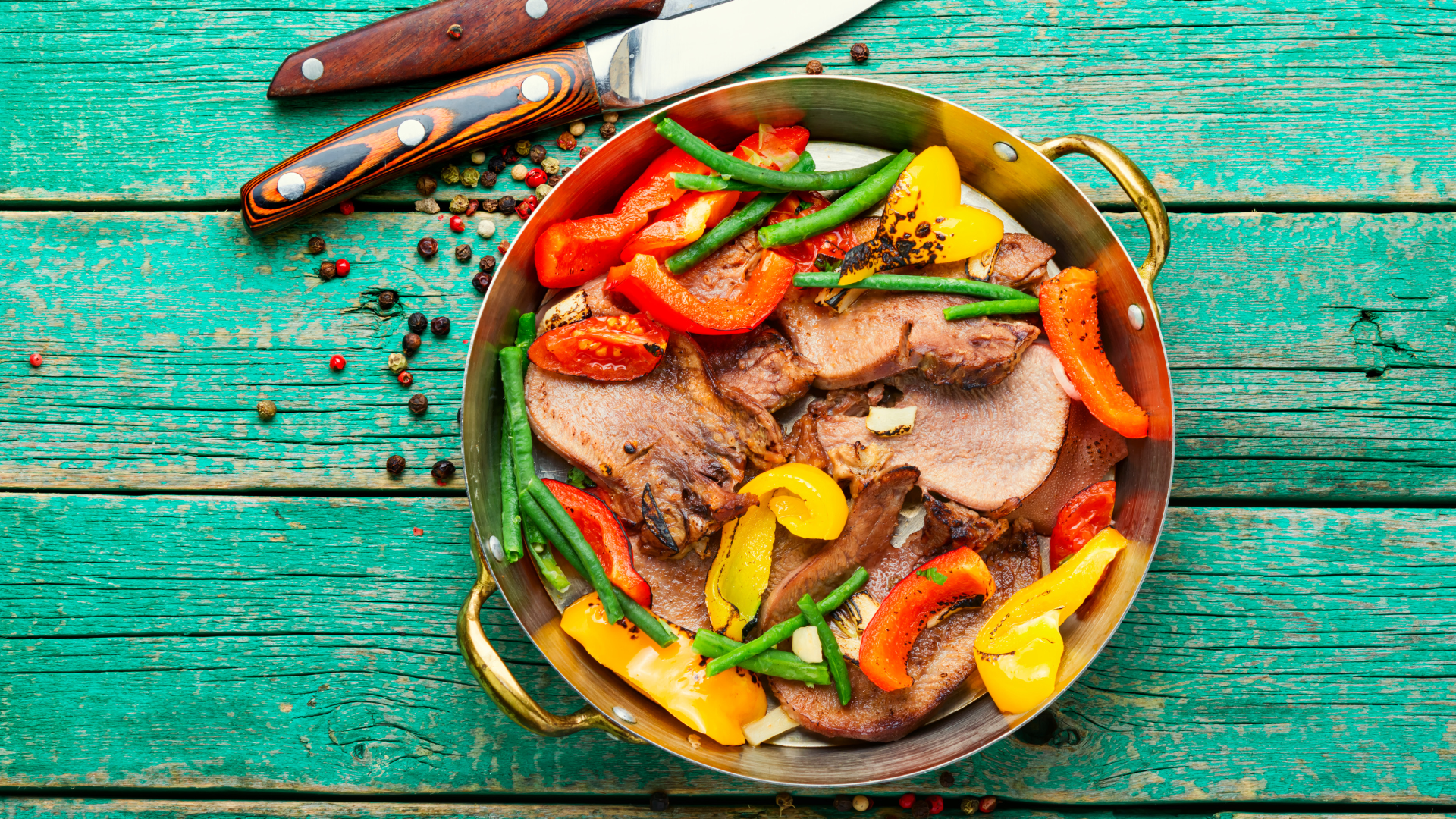
-
Ingredients:
1 beef tongue (2-3 pounds)
2 large carrots, chopped
2 onions, chopped
1 bouquet garni (a bundle of herbs: thyme, bay leaf, parsley)
4 cloves of garlic, crushed
1 cup of dry white wine (optional)
4 tablespoons of butter
2 tablespoons of olive oil
1 tablespoon of Dijon mustard
2 tablespoons of flour (for thickening sauce)
Salt and pepper to taste
Water or beef broth (enough to cover the tongue)
Instructions:
Step 1: Preparing the Tongue
Clean the tongue: Rinse the beef tongue under cold water. Scrub it well to remove any impurities. Some cooks like to soak it in cold water for a few hours to draw out any remaining blood or impurities.
Boil the tongue: In a large pot, place the tongue along with the carrots, onions, garlic, bouquet garni, and a pinch of salt. Cover with water (or a mix of water and beef broth) and bring to a boil.
Simmer: Lower the heat and let the tongue simmer for 2-3 hours, or until tender. A fork should easily penetrate the tongue. During cooking, skim off any foam or impurities that rise to the surface.
Peel the tongue: Once the tongue is tender, remove it from the pot and let it cool slightly. Peel off the thick outer skin with a sharp knife while it’s still warm. This layer comes off easily.
Step 2: Roasting the Tongue
Preheat oven: Preheat your oven to 350°F (175°C).
Season the tongue: Rub the peeled tongue with Dijon mustard, salt, and pepper.
Brown the tongue: In a large oven-safe pan, melt 2 tablespoons of butter with 2 tablespoons of olive oil. Add the tongue and brown it on all sides for a few minutes until it develops a golden crust.
Add liquid: Pour in the white wine and let it reduce slightly for a few minutes. Add about 1 cup of the broth from the boiling step (or water) to the pan.
Roast: Place the pan in the preheated oven and roast the tongue for about 30-40 minutes, basting it with the cooking juices occasionally to keep it moist.
Step 3: Making the Sauce
Remove the tongue: Once roasted, take the tongue out of the pan and set it aside to rest.
Prepare the sauce: On the stovetop, add the remaining butter to the pan juices. Stir in the flour to create a roux and cook for 1-2 minutes. Slowly add more broth or wine to thicken the sauce. Adjust the seasoning with salt and pepper.
Slice and serve: Slice the tongue thinly and serve with the sauce over the top.
Serving Suggestions:
Serve the roasted tongue with mashed potatoes, green beans, or roasted root vegetables.
You can also accompany it with a French mustard-based sauce, a creamy horseradish sauce, or even a caper sauce for extra tang.
This French-style roasted tongue is tender, flavorful, and pairs well with a variety of side dishes, making it an elegant and hearty meal.
Regional Variations
Burgundy: In this region, tongue might be paired with a red wine reduction or sauce, similar to Boeuf Bourguignon, emphasizing the region’s rich culinary heritage of wine and beef.
Normandy: In Normandy, tongue can be paired with cream-based sauces and apples or cider, reflecting the region’s love of dairy and apple products. Langue de Boeuf à la Normande might include cream, apples, and a bit of Calvados (apple brandy).
Alsace: In Alsace, tongue can be served with choucroute (sauerkraut) and sausages in the traditional dish choucroute garnie, making use of smoked and cured meats in combination with pickled cabbage.
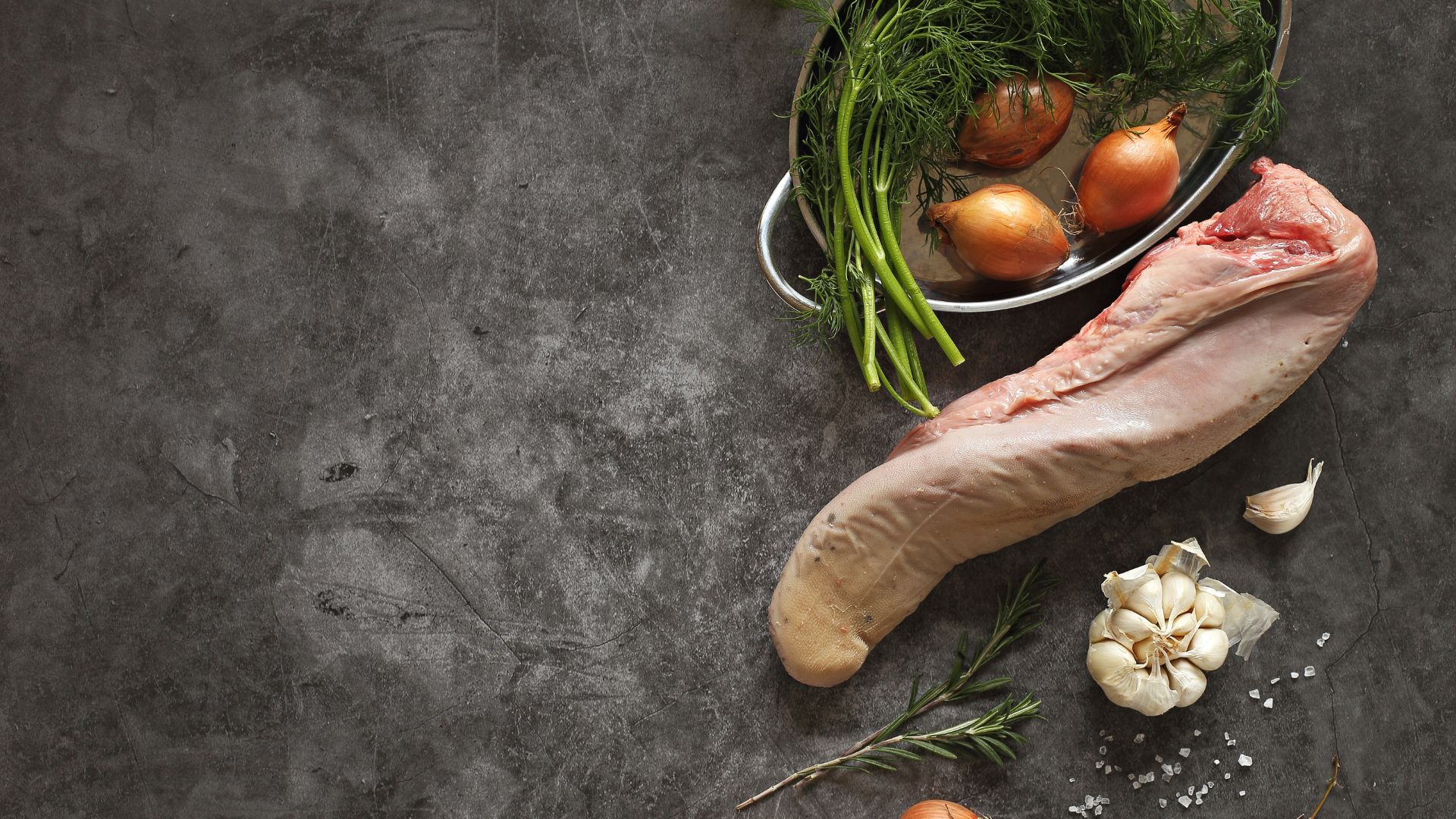
Potted Tongue
Boil two smoked tongues. Skin them and cut them into thin slices. Put the slices (a few at a time) into a mortar and beat them to a paste, adding gradually a pound of butter. Then prepare an equal quantity of the lean of stewed veal, and pound that also in the mortar (a little at a time) with the same proportion of butter.
Then make the veal and the tongue into lumps, and put them alternately into your stone pots, pressing them together so as to look like red and white marble. Have a layer of veal at the top. Press the whole down very hard. Fill up the pots with butter, boiled and skimmed, and pour on warm. Tie them up closely with parchment, and keep them in a cold but dry place.
When you use it, cut it into slices.
History of French Potted Tongue (Langue en Gelée)
Potted meats and tongue preparations have a long history in French and European cuisine. These methods originated from the necessity of preserving meats before refrigeration, using techniques such as salting, pickling, and setting in aspic.
Medieval and Renaissance Roots:
Preserving meat in aspic dates back to medieval times when gelatin was made from boiled bones and used to encase and preserve various types of meat. Potted meats, including tongue, were especially popular during feasts because they could be made ahead of time and served cold, allowing cooks to prepare them in advance for elaborate banquets.
Tongue in French Charcuterie
French charcuterie, the art of preparing preserved meats, includes tongue as one of its specialties. Tongue is often featured in terrines, pâtés, or rillettes alongside other offal. These preparations are common in French butcher shops and are served cold, making them perfect for appetizers or part of a charcuterie board.
Terrines and Pâtés
Tongue is sometimes finely chopped or pureed into a terrine or pâté, where its natural richness pairs well with spices, herbs, and other meats. These dishes are typically served with bread, mustard, or pickles and are a mainstay of French country cooking.
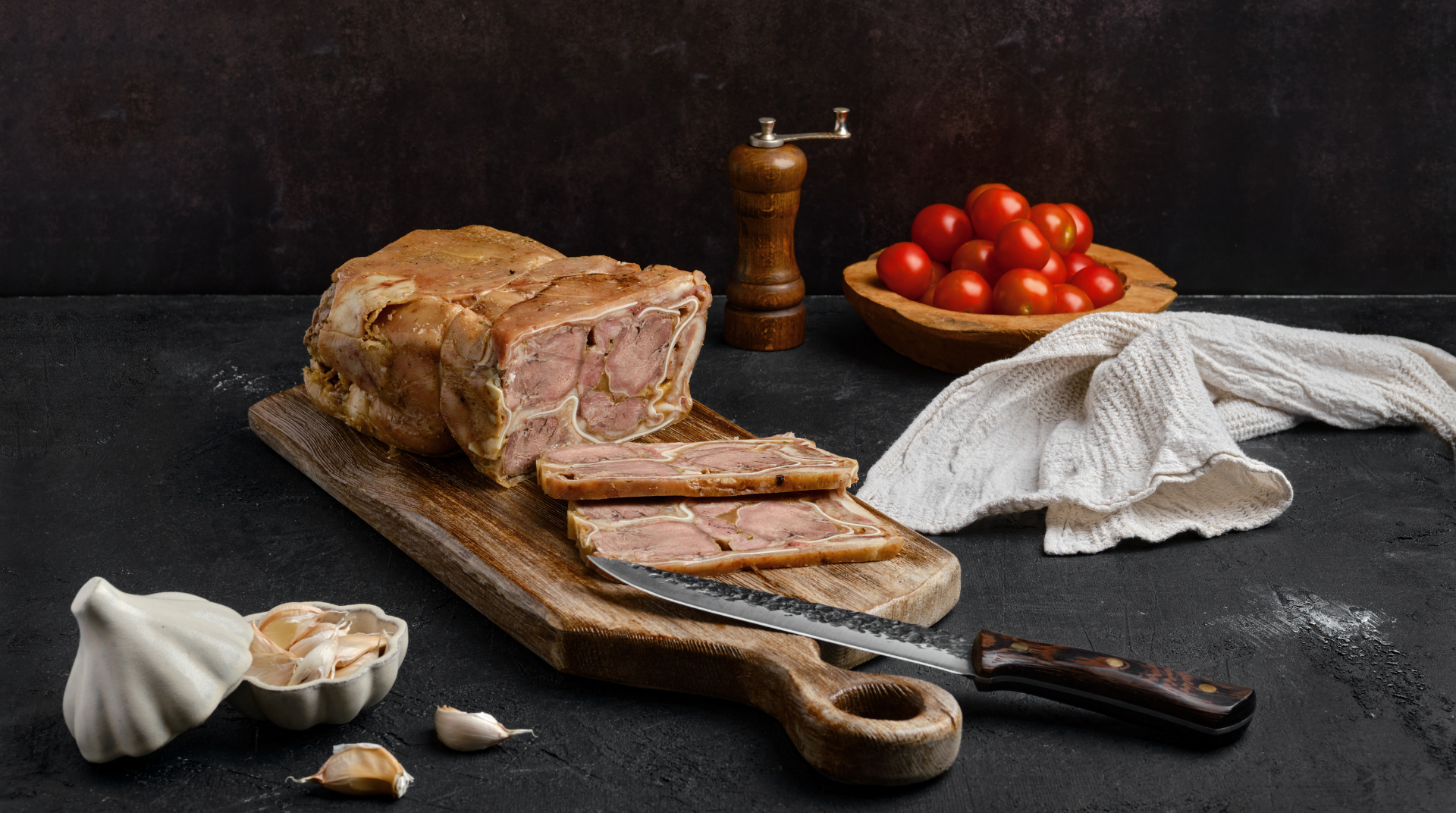
Aspic and Charcuterie Traditions:
By the 17th and 18th centuries, aspic had become a refined culinary technique in French kitchens, particularly in charcuterie. Aspic not only preserved the meat but also allowed for elegant presentation. The gelatin would set into a clear, savory jelly, and pieces of meat, vegetables, and herbs could be artistically arranged within it. Potted tongue in aspic became a classic dish served in aristocratic households and during special occasions.
Marie-Antoine Carême, one of the most influential chefs of the 19th century, is credited with refining the use of aspic in haute cuisine. He used aspic not only for preservation but also for its decorative properties, creating elaborate dishes that were admired for both their flavor and beauty.
A Popular Delicacy:
By the 19th and early 20th centuries, potted meats like Langue en Gelée became widely popular in France, particularly as a dish served in bistros, brasseries, and charcuteries. Tongue was considered a delicacy, prized for its tender texture and rich flavor. It was often served cold in summer, and the gelatin was seen as a refreshing way to enjoy meat.
Tongue has been used in various regional dishes across France, from the rustic countryside to urban restaurants:
In Alsace, tongue is commonly served with mustard and vinegar, a nod to the German influence in the region.
In Burgundy, tongue is sometimes paired with a white wine aspic, taking advantage of the local wines.
Modern Appeal:
Although langue en gelée might seem old-fashioned, it remains a beloved dish among traditionalists and food lovers who appreciate the artistry and care that goes into its preparation. In modern French cuisine, tongue in aspic represents a return to heritage dishes and is often featured in specialty charcuterie shops or served during festive meals.
This dish, while not as commonly found in everyday home cooking today, reflects the timeless elegance of French gastronomy. It showcases both the resourcefulness of preserving meat and the artistry of transforming humble ingredients into something refined.

French Potted Tongue (Langue en Pot / Langue de Boeuf en Gelée) Recipe and History
Potted tongue, known as "Langue en Pot" or "Langue de Boeuf en Gelée", is a classic French dish that dates back centuries. It involves preserving cooked beef or veal tongue in a flavorful aspic (a savory gelatin) and is often served as a cold appetizer. This dish has its roots in traditional French charcuterie, where various meats are preserved and prepared to be eaten cold.
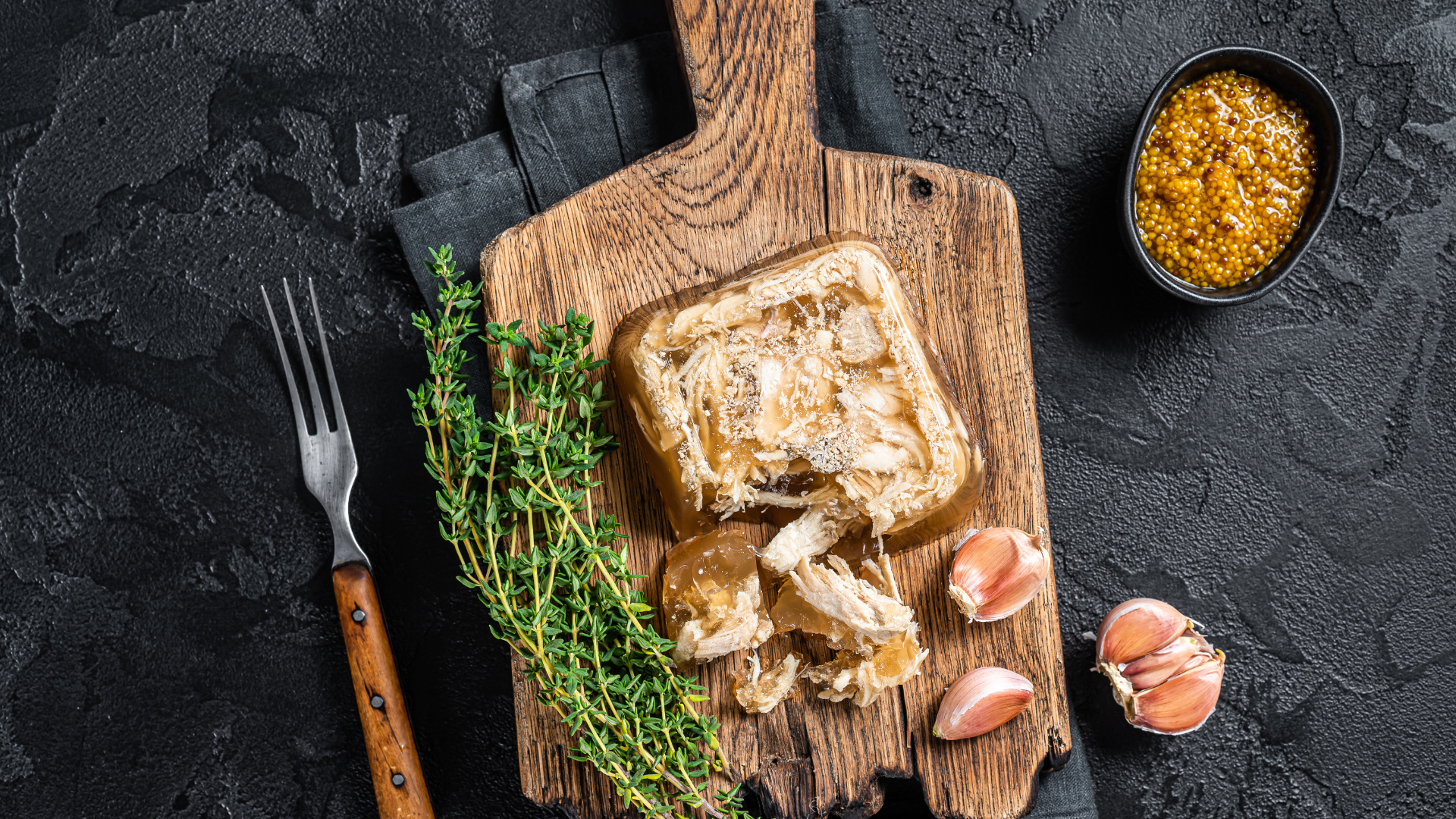
-
Ingredients:
1 beef tongue (about 1.5–2 kg) or veal tongue for a more tender option
1 onion (peeled and halved)
2 carrots (peeled and halved)
2 stalks of celery
4 cloves of garlic
1 bouquet garni (parsley, thyme, bay leaf tied together)
1 tbsp salt
10-15 black peppercorns
3-4 cloves (whole)
1 cup dry white wine (optional)
2 liters water (or enough to cover the tongue)
1 pack (10g) gelatin (or enough to set the liquid into jelly)
500 ml of cooking broth from the tongue
2 tbsp red wine vinegar (or apple cider vinegar)
Fresh parsley (chopped, for garnish)
Instructions:
Prepare the tongue:
Rinse the tongue under cold water. Place it in a large pot and cover it with cold water. Bring the water to a boil and let it simmer for 5 minutes, then drain and rinse the tongue again. This step cleanses the tongue.
Cook the tongue:
Place the cleaned tongue back into the pot, and add the onion, carrots, celery, garlic, bouquet garni, salt, peppercorns, cloves, and wine (if using). Pour in enough water to cover the tongue.
Bring to a boil, then reduce the heat and let it simmer gently for about 2.5–3 hours, or until the tongue is tender and the skin starts to peel away easily.
Peel and slice the tongue:
Once cooked, remove the tongue from the pot and allow it to cool slightly. Peel off the skin while the tongue is still warm (it should come off easily). Trim any fatty parts from the base.
Slice the tongue into thin slices, about 1/2 cm thick.
Prepare the gelatin:
Strain 500 ml of the broth (from cooking the tongue) through a fine sieve. Add vinegar to the broth to balance the flavors.
Dissolve the gelatin in a small amount of cold water, then add it to the warm broth, stirring well until fully dissolved.
Assemble the dish:
In a serving dish or terrine, arrange the tongue slices in layers.
Pour the gelatin-broth mixture over the tongue slices, ensuring they are fully covered. Let the dish cool down to room temperature before placing it in the refrigerator to set for at least 4 hours or overnight.
Serve:
Once set, the tongue is ready to serve. Garnish with freshly chopped parsley and serve with mustard, pickles, or a simple green salad. This dish is typically served cold as an appetizer or part of a charcuterie platter.
Culinary and Cultural Appreciation
In France, tongue is appreciated not just for its unique flavor and texture but also as part of the broader cultural appreciation for offal, known as abats. French cuisine has a long tradition of cooking with offal, and tongue is among the most celebrated of these cuts. French chefs have long valued the skill required to transform what was once considered a humble ingredient into a dish that’s rich, flavorful, and worthy of fine dining.
Modern Usage and Revival
In recent years, tongue has experienced a revival in French bistros and brasseries, where chefs are returning to traditional cuts of meat and preparations. Dishes like Langue de Boeuf Sauce Piquante or tongue terrine are finding their way back onto menus, appreciated by both traditionalists and modern foodies for their deep flavors and connection to classic French cooking.






